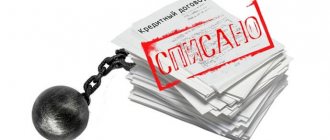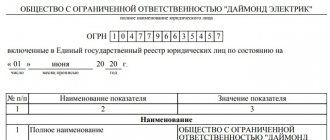Analysis of judicial practice
If you look for judicial practice under Article 196 of the Criminal Code of the Russian Federation, you will be surprised how little there is. That's right: proving deliberate bankruptcy is a very problematic thing, requiring certain qualifications both in law in general and in economic matters in particular. Therefore, law enforcement agencies often take the easier route - they reclassify such cases under the rubber-stamp article of “fraud.” But nevertheless, it cannot be said that the article for deliberate bankruptcy does not work at all.
Here's an example:
Roman had his own individual entrepreneur, which was engaged in retail trade. In September 2010, Roman entered into two loan agreements with Pavel and received $461 thousand.
A month after receiving the money, Roman began to consistently remove his property from under attack: he gave his daughter a plot of land with a house, sold 4 cars and divorced his wife.
Without receiving any payments, the creditor decided to act and went to court. Task: to collect money from Roman under the loan agreement, taking into account accrued interest. In the summer of 2011, the court granted the claim, but Pavel never saw the money - Roman was already homeless by that time.
Then, in the fall of 2011, the creditor filed an application to declare Roman bankrupt. The decision was correct, especially since Pavel had information about the alienation of assets.
Then the situation developed according to the standard pattern: the court accepted the application, the arbitration manager entered the scene, and began to unearth Roman’s machinations. It was then that all the sales and donation transactions came to light. Let us remember that donation is one of the lousiest ways to protect assets, and even more so when it is done in a careless manner.
The manager did not think for a long time and filed a statement with the Department of Internal Affairs, and they, in turn, opened a criminal case. The basis for the initiation was the withdrawal of assets by Roman, which was qualified as deliberate bringing to bankruptcy.
The debtor dodged as best he could: it was not the first time he took money from Pavel, and that he was ready to pay, but it just didn’t work out with the business. In general, the loan agreement dated 2010 is a prolongation of other obligations undertaken back in 2003. As for the gift, it was a gift for her daughter’s wedding, and she certainly could not have known about her father’s debts.
And in general, everything could go according to the standard scenario: application - table - survey - refusal to initiate a case. If it were not for the activity of the creditor and the arbitration manager.
And yet, the outcome of the case was largely decided by the witnesses interviewed, who voiced the following:
- When issuing the loan, Roman and Pavel discussed that the funds were being issued for business development. If the business does not work out, the property - a plot with a house - will go to Pavel to pay off the debt;
- The plot of land along with the house was donated to the daughter, after which she resold everything to her distant relative for 900 thousand rubles. After several trials, it turned out that half of the land and the house already belonged to Roman’s ex-wife;
- It is undeniable that transactions for the sale and donation of property were carried out with the aim of avoiding the payment of debt. The debtor could not forget about debts amounting to almost half a million dollars in a month. Despite the fact that when making these transactions, he assured Pavel that everything would be fine and he would pay everything.
As a result, the court found Roman guilty and sentenced him to 3 years in prison.
But half a million dollars is an amount that can work wonders, so the story doesn’t end there.
The court took into account that Roman was given a positive description by his relatives, there were no similar violations, his elderly mother was dependent on him, and reduced the degree of punishment to 3 years probation.
But that's not all. Referring to paragraph 9 of the Resolution of the State Duma of the Russian Federation “On declaring an amnesty in connection with the 70th anniversary of Victory in the Great Patriotic War of 1941-1945,” the court decided to remove Roman’s punishment and criminal record and did not even impose a fine.
If you are interested in reading all the details of this case, leave your email below and we will send you the verdict in this case:
In general, the story ended more than successfully for Roman. But not everyone is so lucky.
Lawyers have a golden rule: it is easier to prevent a problem than to solve it. And this clearly works in criminal trials: 99.7% of indictments result in an affirmative verdict.
Therefore, the only correct goal when charging with deliberate bankruptcy is to prevent the initiation of a criminal case. I will show you how we at Igumnov Group cope with this task using the example below.
Consequences of deliberate bankruptcy
The result of the presence of the above-mentioned signs is the onset of liability for intentional bankruptcy:
- Administrative . It is determined in the case of minor damage (according to the Criminal Code of the Russian Federation) and is expressed in the form of a fine or disqualification.
- Criminal . Appointed only in case of major damage from a monetary sanction to imprisonment. In this case, a sentence is imposed under Art. 196 of the Criminal Code of the Russian Federation.
- Property civil . In this case, debts are transferred from the organization to the former manager - the culprit in bankruptcy (subsidiary liability).
Our case
I handled the personal bankruptcy case of the director and part-time founder of a number of organizations. Let's call him Oleg.
Oleg was the beneficiary of the plant and several dozen smaller companies.
The plant signed an agreement on the supply of products with one of the creditors, Kirill. Let's say they were bicycles. The products were delivered, but the plant was unable to pay the obligation. The supplier went to court.
The parties entered into a settlement agreement, which the court approved on the following terms: the plant returns half of the bicycles, obligations to pay the balance are transferred to one of Oleg’s companies, and Oleg acts as a guarantor.
A payment schedule was drawn up, according to which not a single payment was made. Since the new debtor never had any assets, trying to collect the debt from him was useless - even bankruptcy would not help. But there was something to take from Oleg, so in 2021 Kirill filed for his personal bankruptcy.
And whoever initiates the procedure calls the tune. In particular, Kirill assigned a supervised manager to the procedure, who began to dig for our client.
Friendly Lenders
As part of the restructuring procedure, the manager performed a financial analysis and identified dubious transactions of the debtor. These transactions formed the basis for the statement of commission of a crime under Art. 196 of the Criminal Code “Intentional bankruptcy”.
The FU proceeded from the following: all of Oleg’s personal debts consisted of guarantees. Oleg owed almost a billion on bank loans that the plant took out. And Oleg’s other companies have accumulated the same number of commitments. In both cases he acted as a guarantor.
But! Oleg vouched for the credit institution back in 2012, and for his companies in 2014-2015 - after it was obvious that the plant would not repay the debt to the bank. At the same time, the companies whose obligations Oleg guaranteed were objectively empty. For example, one did not submit reports, and according to the other, information about the unreliability of the legal entity was entered into the Unified State Register of Legal Entities. director's address and details. What kind of guarantee for hundreds of millions can we talk about if the legal entity is actually dead?
Since these transactions did not make any economic sense, the financial institution concluded that their only goal was to artificially increase accounts payable in order to dilute the share of real creditors and subsequently reduce payments in their favor. We wrote in detail about how this happens in the article “A Friendly Creditor in Bankruptcy.”
The FI's suspicions were supported by transaction figures. Guarantees for friendly creditors exceeded the demands of enemy creditors by exactly... 100 thousand rubles. The situation looked something like this:
Enemy creditors: 1 billion rubles = 49.0009%
Friendly creditors: 1 billion 100 thousand rubles = 50.0001%
And as you remember: the concept of “deliberate bankruptcy” includes not only the actions of the debtor aimed at the direct withdrawal of assets, but also “actions of an indirect nature aimed at creating insolvency.” The latter is precisely what is meant by the debtor artificially increasing his accounts payable.
At the same time, all of Oleg’s friendly creditors were included in the register of claims, which means they had a majority of votes at the creditors’ meeting. And the right to receive a little more than half of the funds from the future bankruptcy estate. A majority of votes of 0.0001% gave Oleg the opportunity to influence the bankruptcy procedure, even if there was an enemy manager.
For opponents, such excavations are a big jackpot. Inspired and encouraged by the creditor, the financial institution wrote down its conclusions in a financial analysis and sent an application to the Department of Internal Affairs.
Types of bankruptcy accepted in legal practice
Based on the peculiarities of the bankruptcy process, real, fictitious and deliberate bankruptcy are distinguished.
In a real bankruptcy, the debtor is unable to restore the ability to repay its debts to creditors due to a real loss of capital, and the presence of outstanding debts makes it impossible to continue business activities.
Fictitious bankruptcy is characterized by a deliberately false declaration by a debtor of his inability to pay debts in order to delay the repayment of debts or completely avoid their repayment.
Intentional bankruptcy is distinguished by the fact that as a result of acts committed by the debtor himself or by persons managing the debtor, a state of insolvency is created specifically to evade the payment of debts (for monetary obligations and mandatory payments).
In practice, this can be expressed in the fictitious sale of property or the sale of property at reduced prices, the artificial creation of excess accounts payable, obtaining loans at unreasonably high interest rates or issuing loans to affiliated persons, the creation of new legal entities and the transfer of the debtor’s property to them in the authorized capital, deliberate understatement the value of assets, the acquisition of such types of services, the cost of which from the point of view of compliance with the market cannot be assessed unambiguously (for example, consulting services).
What transactions of the debtor can be challenged? What is dangerous to do before bankruptcy? Read our article!
Defense strategy
Considering that cases of deliberate bankruptcy are usually based entirely on financial analysis data, the defense strategy we chose was aimed at the total destruction of this evidence in the case. To do this, several sequential tasks had to be solved:
Stage No. 1. Restructuring procedure
At the moment, the procedure was being carried out by an enemy AU, so there were several areas of work here:
- We find violations in the analysis made by the financial institution and send a complaint to the court with a request to recognize it as inconsistent with the calculation methodology established by the by-laws.
- While the court is considering our complaint, we convey to the investigator our position that it is impossible to put this financial deposit. analysis into the basis of a criminal case in connection with its subsequent recognition as unreliable. At the same time, we are not in a hurry to consider the complaint, since there is a risk that the court will refuse to satisfy it.
- At the same time, we are working to maintain the majority in the register of claims in order to change the arbitration manager to a more loyal candidate at the first meeting of creditors (during the transition from the restructuring procedure to the property sale procedure).
Stage 2. Implementation procedure
If the first stage activities are completed successfully, then we will move on to the property sale procedure with a more competent arbitration manager. He will re-analyze the debtor's financial condition, which will probably not reveal any signs of deliberate bankruptcy.
This position will be conveyed to the inquiry body, which will be placed in a very unfavorable position: the case will involve two contradictory figures. analysis, and in order to establish the truth, a third one must be done (in an independent expert organization).
In the absence of proper motivation, not a single investigator will think of wasting time on this, and the case will go into the category of deliberately abandoned.
At the same time, we had two impressive trump cards:
- Unlike subsidiaries, losses and other sins, law enforcement agencies will have to delve into deliberate bankruptcy. But these guys have a lot of work to do, and they definitely don’t have time to study every deal of the debtor under a microscope.
- the ability to replace the manager upon completion of the restructuring, provided that all creditors remain in the register.
Then we began to take action.
Checking bankruptcy for intentionality
To assess the presence or absence of signs of bad faith during bankruptcy, a special audit is carried out. In particular, arbitration managers conduct such checks in 2 stages.
Firstly, indicators (coefficients) of the debtor’s ability or inability to pay debts .
If in relation to at least two of these indicators there is a decrease in their values, then the transition to the next stage is carried out. As part of the second stage, the debtor's transactions and the actions of the debtor's management bodies during the period under study, which led to a decrease in performance, are checked.
The bankruptcy trustee checks whether the transactions complied with the law, and whether the transactions were made on terms that do not correspond to market conditions (for example, on conditions that are obviously unfavorable for the debtor).
Conclusion on deliberate bankruptcy
Based on the results of the studies described above, one of the following possible conclusions is formulated:
- if transactions were carried out or other decisions were made that were contrary to the conditions accepted in the market, then there are signs of deliberate bankruptcy;
- if such transactions or solutions are not found, then there are no signs of premeditation in bankruptcy;
- if documents were not submitted for analysis, then it is stated that it is impossible to establish signs of deliberate bankruptcy.
In itself, the conclusion of the arbitration manager will not be an unconditional basis for holding the debtor or the persons making management decisions liable. But upon the presence of signs, an inspection may be initiated by the authorized police authorities.
As preventive measures, an analysis of the financial condition, assets and operations, analysis of concluded transactions, and control of the market value of assets should be carried out.
Do you want to get rid of debts legally?
Complaint about FU
Considering the manager’s interest in the failure of my client, it was clear that he was turning all events in his favor through the prism of his customer. This means that you can find something to get to the bottom of and show a different perspective on the events in question.
Besides the little things, I managed to catch on to the following basic points:
- Transactions under study. In its financial In the analysis, the arbitration manager analyzed transactions for the provision of guarantees only for a selected part of affiliated persons, and left all the rest without attention. Agree, it’s a strange thing: obligations for more than 2 yards, but only half are checked.
- The nature of transactions. All obligations stemmed from Oleg’s guarantees for his controlled companies. But the guarantee itself is not subject to examination for marketability/non-marketability, since it does not imply reciprocal performance. This is exactly how I played the position in favor of my principal: “Yes, the beneficiary vouched for large sums, but these were companies controlled by him, and he had a direct interest in ensuring that these organizations received the goods supplied.”
I formalized all my theses in a complaint, which I sent to the court. Moreover, we filed the complaint as quickly as possible, so that we could then counter this with the venerable authorities: “Dear ones, while you are looking at the manager’s statement, we are already having a full-fledged dispute in arbitration over this conclusion.”
Active resistance
It is logical that our opponents placed the main emphasis on knocking out “friendly” creditors from the register. In this case, they would not only retain the bankruptcy manager during the transition to the next bankruptcy procedure, but would also receive a majority of votes at meetings.
Thus, an appeal was filed against the inclusion of one of the creditors with a demand to cancel the determination and refuse inclusion in the register. We wrote about how this is done in practice in the article “How to exclude a creditor from the register of claims.”
To help you understand the scale of the problem, let me explain:
- Of the 1 yard of friendly claims, the amount owed to this creditor was more than 900 million. If he drops out of the register, both the votes at the meeting of creditors and the opportunity to appoint another AC are lost.
- The appellate court, considering the opponents' complaint, proceeded to consideration according to the rules of first instance and postponed the hearing. This means that the risks of satisfying it were high.
Meanwhile, there was very little time left before the meeting of creditors, and we managed to change the AU, even if the creditor later left the register.
Based on the latter circumstance, the financial institution appealed to the court with a request to take interim measures in the form of a ban on holding the first meeting of creditors until the merits of the appeal filed by them were considered. He motivated this by the fact that the first instance ruling on including this creditor in the register would in any case be cancelled.
Indeed, if the appeal is considered according to the rules of the first instance, the previously issued judicial act will be canceled. Even if the appeal comes to the same conclusions as the first instance, the reversal will occur on unconditional grounds.
The position of the opponents would be correct if not for one detail: the cancellation of the judicial act on the inclusion of the creditor will occur only after consideration of the complaint. This means that until it is considered, the determination of the first instance is valid.
If the court had granted interim measures, Oleg would have completely gotten into trouble with bankruptcy, and would have most likely intentionally failed, but the court correctly understood the situation, applied the correct rules of law and refused to apply interim measures. Of course, this was not without impressive explanations submitted by representatives of those interested in the outcome. Well, you remember who writes this article.
As a result, the meeting was held successfully - the creditors proposed the candidacy of a new manager and approved it by a majority vote. The bankruptcy procedure has entered its final phase - “sale of property”.
New AU
At this stage, the matter remained small. The new manager did a financial analysis and wrote a conclusion according to which no signs of deliberate bankruptcy were identified. This conclusion was sent to the investigator, and the pre-investigation check against Oleg was terminated due to the lack of evidence of a crime.
I will only note that in the end the court left the creditor in the register, but refused to satisfy the complaint against the financial. analysis of the previous arbitration manager. But if the first event made it easier for us to work on the procedure, then the second one no longer played any role in further events.
This story happened 2 years ago, and today the case can be considered successfully completed.
How to Avoid Responsibility
As can be seen from the practice above, the scheme for attracting for deliberate bankruptcy works in the following format: the manager enters into a bankruptcy case - analyzes the financial situation of the debtor and how it has changed - prepares a financial statement. analysis with conclusions about the presence/absence of signs of deliberate bankruptcy. Read more about the principles of preparation and the role of finance. We wrote about the analysis of the fate of business beneficiaries in the article “Financial analysis in bankruptcy.”
If the AU finds transactions that led to bankruptcy (and this can be either a withdrawal of assets or an artificial increase in creditors), he writes a statement to the Department of Internal Affairs, in which he describes his conclusions and asks to check the debtor for deliberate bankruptcy. The same financial analysis is attached to the application.
Here an experienced reader should have a question: how to do fin. analysis for an individual who does not submit reports, does not keep a cash register and does not take into account accounts receivable, fixed assets and inventory?
I answer: indeed, standard Finnish. analysis of a legal entity is done in 2 stages. First, financial indicators are analyzed, then the economic activities that led to their change. In the case of physical persons, we simply skip the first part with a note about the lack of necessary information, and immediately proceed to the analysis of transactions that entailed the onset of insolvency. As a result of the financial the analysis ends with conclusions about the presence/absence of signs of deliberate bankruptcy.
If an official finds confirmation of the stated facts, a case is initiated. In a situation where the damage to creditors exceeds 2,250,000 rubles, a criminal case is initiated; if less, an administrative case is initiated.
In practice, cases of deliberate bankruptcy are initiated in isolated cases and provided that there is an active creditor and manager who harass police officers and appeal refusal decisions.
Depending on what stage you are at, solve the problem with charges under Art. 196 of the Criminal Code of the Russian Federation can be done in the following ways.
Before bankruptcy began. For every debtor who has gone into bankruptcy, there is at least one transaction that may arouse suspicion. Or it may be interpreted not in his favor.
In order not to guess what the AU can get to the bottom of in tandem with aggressive creditors, it is better to turn to specialists for pre-bankruptcy preparation. Objective: to identify problem areas that can be solved before the procedure begins. Or at least prepare for how they can be beaten in the future.
In the process of bankruptcy. If the conclusion about the presence of signs of deliberate bankruptcy has already been made, your task is to give a different interpretation to the controversial actions. Disputing the financials will help with this. analysis made by the manager.
By the way, right now we are doing exactly this in one of our current projects. We will not give a link to the case: now is only the beginning of the bankruptcy process, but from the point of view of how opponents sometimes twist the facts, the story is indicative.
The arbitration manager, analyzing the transactions of our principal, revealed a drop in the value of the organization’s assets from 570 million rubles to 218 million. He considered that with such a sharp change in value everything could not be clear and stated that there were signs of deliberate bankruptcy.
Since we did not agree with this conclusion, our experts prepared another conclusion, which shows this situation from a different perspective.
Yes, indeed, in 2021, the value of the organization’s fixed assets decreased by more than 2 times, but this was not a consequence of the withdrawal of assets, but a simple revaluation of property. The purpose of the revaluation is to reflect it in the books. reporting the real market value of the asset. And this, by the way, is not a whim of our client, but a requirement of the law on accounting.
Another way to solve the problem is to shift the AU. If it is obvious that the arbitration manager is not playing on your side, and has equally hungry creditors behind him, try to replace him. Our article “How to identify violations of arbitration managers” can help with this.
Liability for intentional bankruptcy
If there are signs of intentionality, the manager or founder of a legal entity, an individual entrepreneur or an individual can be held liable.
Administrative liability for deliberate bankruptcy
Administrative liability for these actions (inactions), if they do not fall under criminal offenses, is provided for in Part 2 of Art. 14.12 Code of Administrative Offenses of the Russian Federation.
The following types of penalties apply:
- in relation to a citizen - an administrative fine from 1000 rubles to 3000 rubles;
- in relation to an official - an administrative fine from 5,000 rubles to 10,000 rubles or disqualification for a period of 1-3 years.
Criminal liability for deliberate bankruptcy
Art. 196 of the Criminal Code of the Russian Federation establishes liability for the same acts that entailed causing damage in the amount of more than 2,250,000 rubles, namely: a fine from 200,000 to 500,000 rubles or in the amount of the convicted person’s income for 1-3 years, or forced labor for up to 5 years, or deprivation freedom for up to 6 years with a fine of up to 200,000 rubles or the amount of income for a period of up to 1.5 years or without a fine.
Are you facing criminal liability?
Sign up for a consultation with a criminal lawyer, and today you will know how to protect your rights.
ONLINE consultation for any city in Russia!
Make an appointment with a lawyer





